|
FAQs about the Yellow-Tail Blue, Palette,
Hippo Tang Environmental Disease
FAQs on Paracanthurus Tang Disease:
PYTB Tang Disease 1,
Pacific YTB Tang Disease 2,
PYTB Tang Disease 3,
Pacific YTB Disease 4,
YTBT Health 5,
YTBT Health 6,
YTBT Disease 7,
YTBT Disease 8,
YTBT Disease 9, YTBT Disease ,
& Tangs/Rabbitfishes &Crypt,
FAQs on Paracanthurus Tang Disease by Category:
Diagnosis, Nutritional, Social,
Trauma, Pathogenic (plus
see
Tangs/Rabbitfishes &
Crypt), Genetic,
Treatments
Related Articles: The
Genus Paracanthurus,
Related FAQs: Pacific YTB Tang FAQs
1, Pacific YTB Tang FAQs
2, Pacific YTB Tang FAQs 3,
Pacific YTB Disease 4, Pacific YTB Tang FAQs 4, YTBT Health 5, YTBT
Health 6, PYTB Tang ID,
PYTB Tang Behavior, PYTB Tang Compatibility, PYTB Tang Selection, PYTB Tang Systems, PYTB Tang Feeding, PYTB Tang Reproduction, Surgeons In General, Tang
ID, Selection,
Tang
Behavior, Compatibility, Systems, Feeding, Disease,
|
|
Surgeonfishes: Tangs for Marine Aquariums
Diversity, Selection & Care
New eBook on Amazon: Available
here
New Print Book on Create Space: Available
here
by Robert (Bob) Fenner |
 |
|
Blue tang illness 12/9/17
Hello Bob and crew !
It has been a long time since my last contact.
Lately I lost view of my blue tang and today I saw him in a bad condition.
<Eeyikes Thanasis! This poor fish is about eaten away... HLLE is the general
term...>
He has lost his blue color and he looks seek. He has not eaten for two weeks at
least. I took a photo of him and I am sending it to you in case you can advise
me what is wrong and if I can help him.
Best regards from Greece, Thanasis
<Perhaps vitamin, appetite stimulant added to the water directly, favorite foods
soaked in it. Please read here:
http://www.wetwebmedia.com/HLLESWCauseF.htm
and the linked files above, and:
http://www.wetwebmedia.com/paracfdgfaqs.htm
And write me/us back with your further observations. Bob Fenner>
|
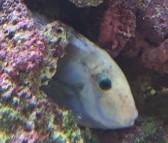 |
Paracanthurus eye issue 11/9/12
Hey Bob.... You know, while I was emailing you I discovered that my
hippo tang has two clear/white outlines around his eyeballs.
Almost like his eyes are being pushed out slightly and there is skin or
something coming out. What could be the cause of this?
<Likely some aspect/imbalance in water quality more than anything...
perhaps biologically mediated... When, where in doubt, change some water
out...>
Besides Epsom salt is there anything else I can do?
<See WWM re eye issues of marine fishes. B>
Thanks again
|
blue tang... no searching, rdg. 1/4/12
As you see from the attachment I have a blue tang who its not
doing so well.
<Mmm, yes... usually water quality and/or nutritional issue/s
are at cause here>
The tank is over a year old so this is not a new tank. There are
2 clown fish in there with her and they have no visible
problem.
<A good clue... able to rule out much in the way of possible
environmental causes>
They all seem to get along. She started her fin decay a few
months ago and I took a water sample to the local aquarium store
and they tested it. They said it looked like my tank was
cycling but other than that everything was fine.
<Toxic/debilitating while cycling>
If everything is ok in there and she is the only one with the
problem then I feel it is probably not my tank. But I do not know
that as I am fairly new to all of this. She eats fine (on most
days) and comes out to play and check things out. Can you please
help. Thanks!
Regina
<Umm, yeah. Please learn to use the search tool and indices on
WWM. Read here:
http://www.wetwebmedia.com/YTBTDisF9.htm
and the linked files above else-wise. Bob Fenner>
|
|
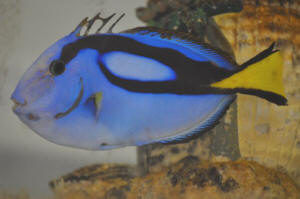
|
|
Sick Hippo tang 11/04/10
Hi WWM Crew,
<Hi Kate>
I recently found your website and thought you might be able to
help/advise me on my current situation.
<Ok>
I bought a 2.5" Hippo tang about 8 months ago and put it in
my 29 gallon tank
<? This fish cannot live here>
with an 8 year old Clown fish (I stupidly did not
quarantine-rookie mistake but neither fish had any ill effects
from it thankfully. I bought a small quarantine tank after that).
5 months ago, I bought a 130 gallon fish tank and let it cycle 2
months sans fish.
<ok>
I have 150 pounds of live sand and about 30 pounds of live rock
in it. I have a SeaClone Protein Skimmer 150, a Fluval 304, a
Rena Filstar XP4, and a heater.
<Mmm, would look to swapping the canisters out, and just
utilizing live rock for filtration here>
I change 25-30% of the water every 3 weeks.
<Good regimen>
I bought a Yellow Tang shortly after setting up the 130 gal tank
and put it in a separate, smaller 10 gallon quarantine tank.
After the 2 months of cycling, I introduced the Yellow Tang to
the main tank first (he was getting stressed from being cramped)
and he has done marvelously since.
<I would have placed the Paracanthurus first here, the
Zebrasoma last>
Next to be introduced was the Clown fish about 6 weeks later,
again with no problems. 2 weeks ago, I introduced the Hippo tang
to the main tank.
<Should have been the first fish, or perhaps second after the
clown>
She hid for about a week before coming out (she was stressed and
she and the Yellow Tang did not get along initially)
<typical>
but seemed fine after that until 2 days ago. She had what looked
to me like classic Ich, little white bumps on her skin, maybe
12-15 of them. I immediately removed her to quarantine (44 gallon
Rubbermaid container) and started treatment with Kordon Rid-Ich
(Malachite green chloride salt and 11.5% formalin).
<This action was pointless I'm afraid Kate. Even if you
manage to rid the Paracanthurus in QT of the parasites, you are
only re-introducing it to an infested system that has an
incumbent Zebrasoma with it's territory marked. Your problems
will repeat themselves, I would have either left this to see if a
balance could be struck with these parasites, or removed all of
the fish for treatment w/ a fallow period.>
Yesterday, her white spots looked like they had flattened out so
I thought the parasites had dropped off of her and continued
treatment, but today she looks like a different fish entirely!
Her eyes are slightly cloudy, she has what looks like a white
film on her sides (the white spots are completely gone), is
lethargic, breathing heavily despite extra aeration and splitting
her time gasping at the top or laying on the bottom. I'm sure
by the time you respond to this she'll probably have already
died. It breaks my heart. She's my favorite fish by far.
<'¦ small qt tank therefore poor water quality,
chemicals present, stress'¦ death of fishes>
I don't understand how she went from fine with a few spots to
near death in so short a time.
<You introduced her to an infested system with an incumbent
Tang>
Do you think having her by herself is making her worse?
<Yes>
She seemed to get drastically worse after putting her in
quarantine and treating her for Ich... Should I continue
treatment, change treatment (if she's still alive)? I'm
not sure what this could be. I'm also concerned for the other
2 fish in the main tank. Neither are showing any signs of disease
yet. I don't know where I went wrong and how she got whatever
she has. Any advice would be greatly appreciated!
<Would place the fish back to display system, in the sump if
possible, away from the others to recover while you ponder your
next move>
I attached a picture of the Hippo Tang in a clear plastic
container so you could see her.
<Yes.. ragged fins like that are sure-fire indicators of poor
water quality, poisoning, and the cloudy eyes'¦ this
QT system & it's water is not suitable for this
fish>
Kate
<Simon>
|
|
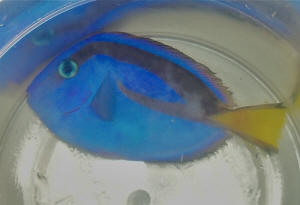
|
| White patch on Blue Tang
(Paracanthurus) 11/30/07 Hello WWM crew... I
have a blue hippo tang with white patches all over it's body (I
have included pics). <I see these> This has happened on two
occasions. The fist time, it wasn't that bad, and In asking
advice from aquariacentral.com.. they suggested that the cause was
the tang not getting enough green's in it's diet. <Mmm,
maybe... not the greens per se though> I then fed it greens, and
it went away within a few days. Now, just a few weeks later, it has
happened again, except this time it is a lot worse. I again went to
AquariaCentral and they suggested that it is stress (caused by
possibly the damsel). <Possibly a component as well> I have a
very tame damsel, and it never bothers the tang, however
occasionally I will see the tang chase it around, however it has
always done that. (5 month old tank) Here is the thread on
AquariaCentral regarding my problem:
http://www.aquariacentral.com/forums/showthread.php?t=131877 Tank
Specs: 55 Gallon, <This species, Paracanthurus, needs more room
than this...> 1 Blue Damsel, 1 Blue Hippo Tang, 1 Yellow
Watchman Goby, 1 Hi-fin Goby, 1 Banggai Cardinal, 2 Scarlet Skunk
Cleaner Shrimp, 3 Sexy Anemone Shrimp, 1 Sand Sifting Sea Star, 1
Serpent Sea Star, 1 Brittle Sea Star, <What species? If
Ophiarachna in particular, this animal could be over-stressing the
Paracanthurus by night> various crabs/snails for a clean up crew
Water parameters are all fine (0 Ammonia/0 Nitrite/ 15-20 Nitrate).
<This is borderline... too high... another source of stress...
the real "cause" here> Do you believe that it is
stress that is causing the tang to produce these white patches?
<Yes> Currently the patches are starting to fade, however I
wish to try to prevent this problem from happening again... Thank
You! -Jessica <This is a "good" email in that
you've provided most all the useful, pertinent info... A few
"things" would help here... A larger system, the addition
of a living sump (refugium), the culture of macroalgae there and
its feeding to the tang, perhaps the addition of "mud"...
This is a HUGE amount of material to introduce to you... not
knowing what you already are aware of. Please take the time to
peruse here: http://wetwebmedia.com/marsetupindex2.htm Jotting down
notes, more specific questions re these aspects of set-up,
filtration. Oh and the survey piece on this species:
http://wetwebmedia.com/paracant.htm and the linked files above. Bob
Fenner> |
|
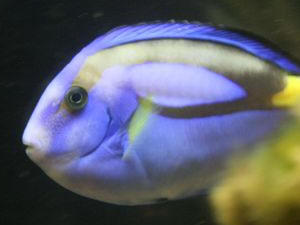 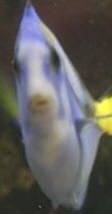
|
|
Blue tang in danger!! Inappropriate home
6/6/07 Hi there, <Hello> Here is my setup (or what I
know of it... I bought it used for 200$ from a guy on the net who
said he did not have time to care for it anymore). 33Gal tank one
Fluval 303 and two power head in there is three large live rock
two clownfish 1 cleaner shrimp (used to be two but lost one in a
day of big heat before the A/C was installed) about 4-5 turbo
snail and more I don't know about yet ! Yesterday I decided
to do a little tweezers treatment on my live rocks as there where
many Fireworms and I saw them eat away at a snail who is now dead
of course! <Mostly likely dead or dying already, and they were
just cleaning up.> I also carried out a cleaning of the live
sand and replaced about 40% of the water (maybe too much here !)
<I would limit it to 25% unless there is a real emergency.>
This morning I noticed that my blue tang was staying at the
bottom and breathe very rapidly he refuses to eat I am afraid I
might lose it ! <This tank is way to small for a blue tang,
they need a tank at least 100G larger than what you have.>
Water parameters are (ammonia 0 to 0.1 hard to read !! NO2 is 0
and no3 is about 50 ! salinity is 1.0235 Used to range in the
1.024 to 1.025 when I first got it (that might also be it the
reason right ?) <Not likely, not enough of a change.> There
does not seem to be any spots other than the HLLE that it came
with which is very minimal and concentrated in the eye area (not
in the yes but in front) I don't really know what to look for
I think I might have an Aiptasia outbreak but they are very
little about 1-2 mm diameter and 5-7 mm long and there are two
large ones about 1cm wide to 2-3cm long buried in the live sand.
<Not the source of your problem here.> I will include
pictures of the Aiptasia and other life forms found for referral.
Please help my tang !!! It does not want to die ! Thanks !
<Not much to go on here. First guess would be that there was a
fall in water quality, either an ammonia spike, or too drastic of
a change in temp, pH, or other parameter when you conducted the
water change. Could also be the first signs of ich or other
parasite, they attack the gills first. Either way the long term
survival of this fish is doubtful in such a small tank honestly.
Also please spell and grammar check your mails before sending
them, correcting them before posting takes away time we could be
using to answer questions.> <Chris>
|
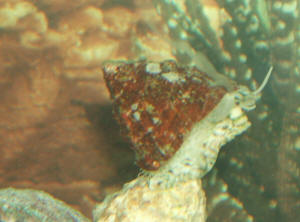 .JPG) |
.JPG) .jpg) |
| Blue tang disease, infection?
5/2/07 I read through your site often and refer people here all
the time. I own a fish store and have occasionally come
across this same situation. Mostly only occurs with Blue
Tangs. When I received this fish she was fine and
beautiful. I performed my normal acclimation procedure
for all of my new fish. <Does this/it entail a dip/bath? What
chemicals do you use if so? Is it pH adjusted?> I have had this
blue tang for over a week now, she eats, and is fat and healthy,
when I came into my store yesterday she had swelling on top of her
head, as if she had un into something and injured herself (which is
common for them to get spooked from customers etc), <Yes> in
this situation I observe and do my best to keep them eating and
calm, <Best to place such fishes in "high" up and away
tanks...> today when I came into the store the top of her head
is rotting away. My system holds approximately 600
gallons, ammonia 0, nitrite 0, nitrate 0. This system
always contains copper. <Mmm... not uncommon, but not
recommended> and specific gravity is at 1.019.
<And... I'd keep this a few thousandths higher...> All
other fish in same system are fine, including other blue tangs,
which have been in system for over a month. In the tank
with this blue tang is (Vlamingi tang, Leopard Blenny, Klein's
butterfly, Foxface Lo, Longnosed hawk). I have included
some pictures in hopes you can help me to identify what this could
be, I love all of my fish and only want to help them the best I
can. Thank you so much Wendy <Very nice specimens... judging
from the very yellow underside... from New Caledonia or
thereabouts... Likely the damage initiated in capture, holding,
shipping... but the copper exposure and unnaturally too-low spg is
not helping... If this fish were mine, I would remote it to your
invertebrate system (in a good sized/volume tank) as you likely do
with your seahorses, Pipefishes, clowns... Sans the copper and with
NSW spg of course there. Further... if I might influence you, I
encourage you to revise your receiving protocol and do away with
constant copper use. The rationale, instructions for these is
posted... on WWM. Bob Fenner> |
|
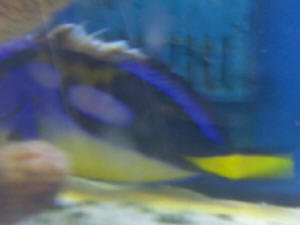
|
Hippo tang in need of immediate help - possibly
ringworm? Hyposalinity... 3/5/07 Dear Bob, <Ryan> I
searched high and low on your website for an answer to this
question but I could not find one. I was hoping you could shed some
light on the issue and put me out of my ignorance. This hippo tang
has rings all over its body. <I see this> I have enclosed
some pictures for you to see. Currently, the fish is in
hyposalinity to get rid of ich. The specific gravity is at 1.008,
<This is a/the problem... Paracanthurus don't do well in
such low salt densities... See WWM re Crypt, Hyposalinity... this
is simple stress marking> ammonia and nitrite are 0, nitrates
are 10, temperature is 79, and the pH is 8.3. I have had people say
that it was the beginning of head and lateral line erosion, gas
bubble disease, or maybe, side effects of hyposalinity.
<Bingo> I performed hyposalinity on two times in the past in
a quarantine tank and have never seen this happen to a fish. Any
advice you can offer would be very much appreciated. Ryan Smith
<BobF> |
|
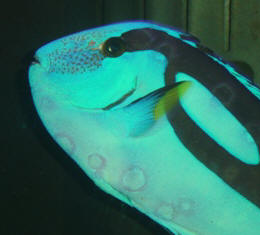
|
Blue tang
sick......please help 2/9/06 I purchased a blue tang
from a very large and reputable LFS about 2 weeks ago and
since I bought him he just keeps getting worse! In my almost
2 month old 150 gallon tank I have
* Yellow moray (
3 feet) * Zebra eel
( 4 feet)
* Miniatus Grouper (
5 inches) * Marine
Betta ( 5 inches)
* Maroon clown (3
inches)
* Large bubble
tip anemone * Naso
tang ( 6 inches)
* Yellow tang (
3 inches) * Blue
hippo tang ( 5 inches. very sick!)
* 15 large
soft corals I have VHOs with more than enough lighting (just
below requirement for frags) and 160 pounds of live rock.
All my parameters are in check although just yesterday I did
get a nitrate spike (in safe levels however) <Numbers please>
but everything is fine now¦ anyway on to the sad
part. For about 2 days he swam around (the hippo) and shook
while swimming occasionally swimming on his side although he
definitely did not do this in the LFS! Anyway after that he hid
in the rocks and pretty much stayed there since
now¦.. about 2 weeks (no eating, swimming, hardly
any activity whatsoever) he dame up today leaning on my
snail on the glass not moving and I caught him with my net
<Must be sick!> and made a protective plastic
sanctuary at the top of my tank with a cut laundry basket with a
little home from shade from the light and etc. Now that I
see him he has transformed from the beautiful fish I bought,
into a fish with faded blue spots and his yellow tail looks
like a beat up feather duster and is off white from the
bright yellow it used to be. There is also a cluster of tiny red
spots oh his tail which I have no idea what it is. He looks
awful please help me I have read over 200 inputs with no real
definitive answer and am blue in the face with no progress.
It would be a shame if he didn't make it Thanks so
much <Very likely this new fish is reacting to a
chemical "soup" situation your other fishes have become
classically "adapted" to... their combined wastes, the soft
corals... If you want to save this fish it needs to be moved to other
quarters pronto... The overstocked situation in your 150... I'd
stick to what you have. Bob Fenner>
Nitrates and regal tang 12/17/05 Hey!
<Hey, Hey> Guys believe me I did a lot of reading
before mailing you. <I believe you>I have a 140G tank and
considering the decorative corals and sand and rocks it would come down
to 120G of water. I checked my nitrates on my Tetra No3 and the color
code matched between 50-100. 100 is the max reading on the rate card so
that scared the sh*t out of me. I had done a 10% water
change on Sunday & checked No3 on Tuesday to get this reading. I
had unfortunately not done a test before. My regal tang(2", 6
months old in my tank) all off a sudden started hiding and when on a
hunger strike which made me do the test. I still wonder what's
wrong with him as my other tank mates which include a fire clown,
yellow tang, Purple Fridmani, Strawberry Goby, Blue devil; are doing
very fine and are good at eating etc. My other water parameters are
Ammonia 0, No2 0, pH 8.1 yes I am increasing it to 8.3 already. I have
got the pH up from 7.8 to 8.1 in a span of 15days and will get it to
8.3 soon. I did another water change yesterday (around 15%) i.e.
Thursday and still my No3 remains the same. <You need to control
nutrients my friend. Read here. http://www.wetwebmedia.com/nutrientcontrol.htm>
My filtration includes an EHEIM 2217, a UV after that and a Overhang
Wet/Dry. The water flows from the 2217 to the UV and finally to the
Wet/Dry and back in the tank. I changed my carbon Bag in the canister
on Sunday itself. How do it get rid of the Nitrates? <Carbon should
be replaced monthly. Consider using a higher grade such as
Chemi-Pure. The filter floss needs to be changed on a weekly
basis also.> Have the high nitrate levels caused the regal tang to
go on a hunger strike? <Very possible as tangs do require pristine
water quality and a high vitamin diet.> I haven't fed anyone for
the last 48 hrs. Please help me out with the same. <Most fish will
tolerate nitrate levels around 25ppm with no problems. At the level you
are at would be questionable. Keep in mind there is nothing
you can buy and/or add to the tank that is going to make the nitrate go
away overnight. I'm also thinking a hang on wet dry
isn't going to have the area you require for efficient biological
filtration for a 140 gallon tank. Do read the link and
I'm sure you will see areas that you are failing
in. <You do not mention the use of a protein
skimmer. This alone helps immensely in controlling
nutrients. James (Salty Dog)> Thanks in advance
<You're welcome>
Blue Tang looks powdery and nitrate levels Hi guys,
<Hello, Mike> I have a 75 gallon Sea Clear II system that has
been up for almost one year. I am currently running two in tank
circulating pumps (one in each corner) and have stocked the tank with
approx. 70 lbs. Of live rock (it is hard to remember). Presently it is
running as a FOWLR set up my current residents are a pacific yellow
tang, mandarin goby, (3) fire gobies, orange spot goby, convict goby,
black percula clown and my newest addition is a blue tang. He
seems to have adjusted to the tank well enough and he has been with me
for about three weeks now but recently I have noticed that he is
scratching himself frequently on a large shell and he appears to look
kind of powdery on some angles. So my first question is from my humble
description do you have any wisdom to bestow on me about my Blue
Tang? <Mike, part of your problem is that your tank is
overstocked. You really don't have 75 gallons of water after you
put in 70 lbs of live rock. Tangs are very prone to ich and the
overcrowding isn't helping matters. Seven gallon weekly water
changes are almost a must in keeping tangs healthy along with an algae
rich diet. I would get an iodine supplement such as SeaChem's and
dose weekly. It should help the fish out some. You also might want to
try a garlic supplement added to the fish food. My answer to helping
the tang out is that you would have to try and net the tang out and
treat in a quarantine tank, or take your chances. In doing the later,
you may lose all your fish.> My second question is do you have any
advice on lowering my nitrate levels? I have never been able to get
them below 45 ppm. I “blow” the LR approx. once a week and
do a 10 gallon water change every two weeks. My protein skimmer in an
HOB Red Sea Prizm (not the greatest I know). Two weeks ago I built a
denitrator coil and installed it; also at the recommendation of a
fellow enthusiast a replaced my bio balls with live rubble rock
(seasoned for many years at the LFS). As of today my nitrate levels are
down to approx. 35 ppm (still high I know) but this is lower than they
have ever been. I would love to do some coral but my level most
obviously be much much lower. Can you help me with my
misery? <Mike, with the overstocking you have, you are
importing more nutrients than the system can export. Find homes for two
or three of your least favorites. I'm guessing the tangs are
probably at least three inches long? My rule of thumb is one cubic inch
of fish per five gallons. I'd start by doing the later and employ
weekly 10% water changes. This is something I do on a regular basis,
problems or not. Add a couple units of ChemiPure to help get rid
of some of the nutrients. This filtering media employs excellent
scavenging resins and aids water quality both visually and chemically.
When doing water changes, do use a vacuum type siphon to suck out
detritus in the gravel. Blowing the live rock just puts the mess in
another place. If you are using filter pads, change weekly. Hope this
helps you out, Mike. James (Salty Dog)>
Established Blue Hippo Tang Thanks Bob and everyone else for
a great site- it has been invaluable. I have a 50 Gallon
well established saltwater aquarium. I use a Penguin 170
Bio-Wheel filter and a SeaClone Protein skimmer both of which have
worked great. I try and do a water change weekly, I keep the
specific gravity at 1.021-1.022, and I only use high quality filtered
water that gets rid of most nitrites, nitrates and keeps the PH very
stable. I have a clown fish, a blue hippo tang and a diadem
Dottyback. They have been living in relative harmony
for over a year. The Blue Tang has amazingly never caught
Ich but has been very sensitive to water/temperature/environmental
changes. A few days ago we had a very warm day on the Jersey shore and
I completely forgot to adjust the tank temperature. I looked
in horror at the tank when I realized it was over 90
degrees. The blue hippo tang stopped eating and seemed to be
lingering around the bottom sides of the tank, being swept along with
the current from the protein skimmer. I immediately did a
water change and a slow decrease in temperature. The color
has remained good but it has started to fade, the face has gotten a
little transparent but there is absolutely no sign of ich.
<Your system itself is very likely ich-free...> The blue hippo
tang seems to be in distress as it is not swimming naturally and
doesn't seem to be able to leave the sides of the tank due to
weakness. I'm worried and she doesn't seem to be
eating much (marine vegetables, Mysis shrimp, high quality flake
food). I did a fresh water bath per your instructions and it
didn't seem to help. This happened one other time with the tang,
very similar behavior, I did a fresh water bath and the next day it was
bouncing around the tank like nothing had happened to my relief and I
was praising this website :-). It has been 3+ days now and I
don't like the looks of her. Any help would be much
appreciated. Thanks again. <The fish is/was likely
thermally stressed... should recover in a few weeks time. Bob
Fenner> David
Hippo In Distress Hi, I have a Hippo Tang, Yellow Tang, Molly
Miller Blenny and 2 Chromis. I battled ich with the Hippo
Tang for 6 months (only fish affected). It finally seemed
gone when I combined Seachem's Metronidazole in the food with Kick
Ich. Fish has been clear of ich for several
weeks. Medicine was removed with charcoal and water changes
6 weeks ago. About 2 weeks ago, I noticed one Chromis
appeared a little dark and kind of quivers in place most of the time
(not too unusual for him - but a little more than usual). A
few days later, most of the Blue on my Hippo Tang had turned very dark
(especially around the head). I searched but could not find
an illness that fit the description. Neither fish is
scratching against rocks and both are eating well. I did
some water changes. Four days later, the Hippo's color
seemed normal and the Chromis was no worse. Then a few days
later the Hippo darkened again - only to look normal after a few
days. Today, the Hippo is "blacker" than
ever. He looks like someone airbrushed his head and part of
his body with black or very, very dark purple (most of it - other than
the blue in the center of the black markings). One of his
eyes is also matte over this time (used to do that with ich - but has
been clear for 6 weeks). The Chromis still looks a little
"dull" colored. Do you think this could be black
ich - or have any ideas? Nothing has been added to the
tank. No other fish are affected. Thanks, Doug <<Dear
Doug; Black ich is easily recognized, it looks like white ich, only
black...in other words, small, irregularly placed spots on the body of
the fish. Easily seen on most tangs. Freshwater dips will take care of
it, or Cupramine in a hospital tank. However, I do not think this is
your problem. It sounds stress related. You do not give any water
parameters, so I will need you to email me back with the following
info: You used Kick Ich, is this a reef tank? What does filtration
consist of? What are your ammonia, nitrite, and nitrate levels? Is the
pH stable? Temp stable? Do you dose anything? ALK? CA? How often do you
usually do water changes, and what size is this tank?? Do you see any
aggression between the tangs? What do you feed them? Any other unusual
behavior? Any signs of HITH? Please get back to me with this info.
-Gwen>>
Hippo In Distress II He was much better this
morning - more like his old blue (a little darker around the head and
above his fins). Then this afternoon he started looking more
and more black! Maybe it is stress - but I can't figure
out what is bothering him (other fish do not harass him). The only
stressful thing I can think of has been a couple of quick power outages
(several days ago - due to storms). However, there is a
grounding probe on the tank and his color has been going back and forth
since then (without any more outages). The tank is a 120 gallon bow
front (48 inches in back and 30" tall). We plan to move to a
72" tank soon - but he is only about 3" now (so I think he
should have enough room). Filter - Ecosystem Caulerpa (with 10% water
change per week) Water Parameters: Salinity 1.024 Nitrate - 10 (usually
not detectible - I will do a 5 - 10 gallon water change tonight)
Nitrite - 0 PH - 8.0 (runs a little low - I will be adding a little
reef buffer to make up water) Temp 80 - 81 In case my test kits are off
- would PH or any measure in particular possibly do this to a Hippo
without affecting anything else (other fish, snails, shrimp, etc.)?
Also, when we move up to a 72" tank we are probably going to get a
wide, short tank (26" wide and 20" tall). Will
that 20" height be adequate for the Hippo and Yellow Tang? If we
get him over this, I think we will move to the new tank very
soon. What type of quarantine do you recommend for the Hippo
(between his ich and this we know we must run the new tank fallow for 6
weeks and will quarantine him separately, Should we treat him with very
mild copper to make sure all ich is completely gone during part of the
6 weeks - he has had a spot or two since the kick ich/Metronidazole so
I know he is not completely cured - but most days over the past six
weeks he has been ich free). Thanks again from me and my "problem
child," Doug <<Doug; Your pH does concern me. You would
generally want to keep it anywhere from 8.2 to 8.6 (yes, some people do
go this high) because it does fall at night, and if your pH is 8.0
during the day, it could fall as low as 7.6 at night...too low! This
itself might be the sole stressor your tang. Thing is, your pH is also
affected by other things, and affects other things... what else do you
test for? Alkalinity should be next on your list. Yes, you can q-tank
the tang, it might be a fine idea to quarantine both tangs. If you use
copper, go with Cupramine. Also, from what I read, your sole filtration
is Caulerpa. You might want to upgrade your filtration, either with a
skimmer, a deep sand bed, or bioballs, whatever. Do some reading, and
pick the one you like best. All filtration methods work well, if you
understand them and their proper applications. In the meantime, a few
more water changes might be in order...you know: manual filtration :P
-Gwen>>
Hippo In Distress Again! Hi Gwen, Looks like you were right
on the money with the PH. It was dropping from 8 to around
7.6 at night. The cause was
2-fold: 1) covered tank and
2) Phosphate remover. We removed both and added
reef buffer slowly. PH is holding it's own now around
8.3. Unfortunately, a little red slime came back (which is
why we used the Phosphate remover). We are battling it with
water changes. <<Running a high quality carbon will help, also
Chemi-Pure.>> Our Hippo is looking a tiny bit
better. Still has a black face, but a tiny bit more blue is
showing on his body. I'm sure it may take a few
weeks. He is still eating and swimming great so hopefully he
will fully recover! <<I hope so too.>> The new tank comes
in a month. It will have a protein skimmer along with the
mud filter (Ecosystem advertises not to use a skimmer - but for us that
only worked for a year then went downhill fast)! Before moving the fish
and live rock, we'd like to do two things: 1) make sure
ich is totally gone, and 2) get rid of as many or all Bristle worms if
possible. <<Why? Bristleworms are excellent detritivores. Why
remove them? Their number will balance out with the amount of nutrients
available to them...if you remove some (and you will only be able to
remove SOME) the rest will simply re-populate the tank until you have
just as many as before...>> We don't want to stress the Hippo
any more so I plan to wait until his color is back to normal before
removing any of the rocks and putting him into quarantine (unless of
course he gets worse instead of better). I'll replace
the CopperSafe we bought for emergencies with Cupramine. And
of course, I now have more questions! <<Okay>>
- What is a good but very low level of Copper for the Tangs
and how many days treatment are necessary to ensure it is gone (neither
shows signs of ich right now)? <<I will assume you mean to use
the copper in the q-tank only. A good level is the level listed on the
product label: one milliliter for each 40 litres, every two days, for
14 days...(sorry, I'm Canadian, read yer own label :P) Use a good
copper test kit to keep the level safe. Do not exceed 0,6ppm. Test the
tank before each new addition of copper!>> - Should we
go ahead and quarantine the Blenny and Chromis with low dose of
Cupramine just to be safe? <<I don't believe it's
necessary, but then, I can't see the condition they are in. You
must make some judgment calls.>> - If they can be
treated together, can they all go into a big Rubbermaid container with
plenty of plastic hiding places (they all get along now)? <<Sure.
Just make sure the water parameters are stable.>> - Or - we could
move the rock and all inverts out of the existing tank and treat them
in it - except I heard not to ever use Copper in acrylic tanks (let me
know if that is not true). <<Don't know about acrylic, but DO
NOT treat your main tank!>> And two Bristle worm elimination
questions: - Will 1.035 salinity dip (said to make bristle
worms come out of the rock) hurt mushrooms and xenia for a short
time? We have a couple monster (30 lb.) rocks that are
nicely covered with those corals - but the rocks also have Bristle
worms that have been hard to get rid of (we would love any other ideas
on how to get rid of them as we move tanks). - Would taking
the mud out of the sump and "sifting" it to try and remove
all the worms while leaving amphipods, etc. work or would the larvae
most likely still be there (should we go ahead and pay the price to
change all the mud)? <<See above re: bristleworms. They are good.
Keep them. Trying to remove them will result in dead pods, anyways. Why
bother? Is there a necessary reason for their removal?>> Thanks a
million once again! - Doug <<Most welcome. -Gwen>>
White spot on my blue tangs. Hi there...sorry to bother
you... I am just beginner on marine reef. I just recently
bought 3" blue tangs <Tangs? Not tang? You mean more than
one?> for my 33 gallon tank <Uh-Oh!> before I put him to my
tank. I just changed the water after 5 hr then I put my blue tangs
inside my tank. After 2 days I saw white spot on the body but
the tangs seem good in swimming and eating very well only the
white spot on his body. what should I do? <One white spot? Watch
carefully for a while. I wouldn't worry too much about one spot.
However, these fish are known as "ich magnets" and it is
certainly possible this fish may have ich. He needed to be placed in a
quarantine tank before being placed in your main display> must
I change the water? I check the NO2 and its ok. What is the
problem bob and what must I do? <My friend...I see a couple of
problems...Your tank is really too small to house a blue tang long
term. I know it probably looks like it's doing alright
now but he will grow...up to 12"! Here's my advice: Before
purchasing any other fish get a good fish book. Michael Scott has a
book called "Marine Fishes". It's a small pocket size
book that is needed by virtually all hobbyists. Secondly...you also
need a good book on husbandry techniques. I suggest Bob Fenner's
book "The Conscientious Aquarist". Lastly, peruse the
WetWebMedia.Com facts and articles section to learn the basics about
aquarium setup, water chemistry, aquarium husbandry and much, much,
more! David Dowless> thanks <You're welcome! Keep reading and
learning!>
Surgeonfishes: Tangs for Marine Aquariums
Diversity, Selection & Care
New eBook on Amazon: Available
here
New Print Book on Create Space: Available
here
by Robert (Bob) Fenner |
 |
|
|

